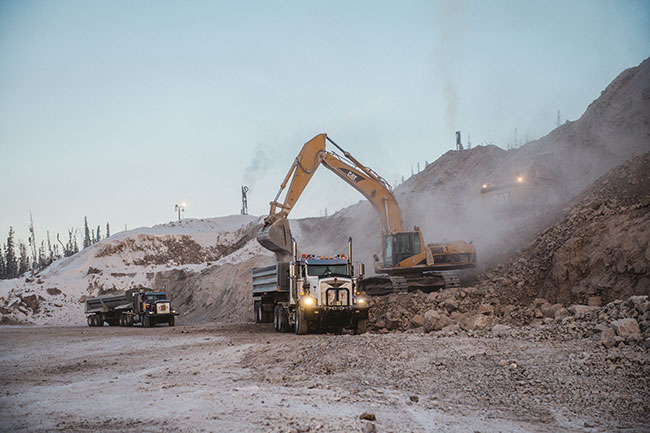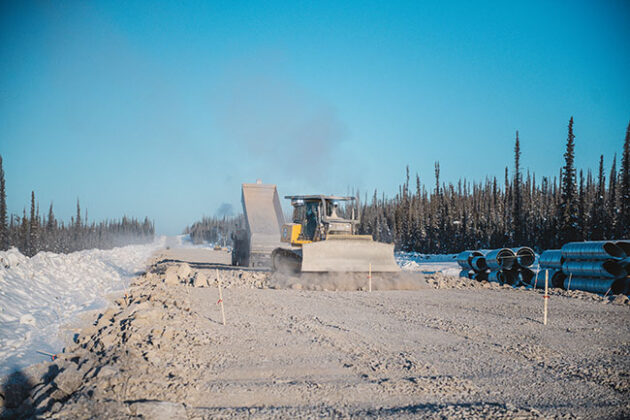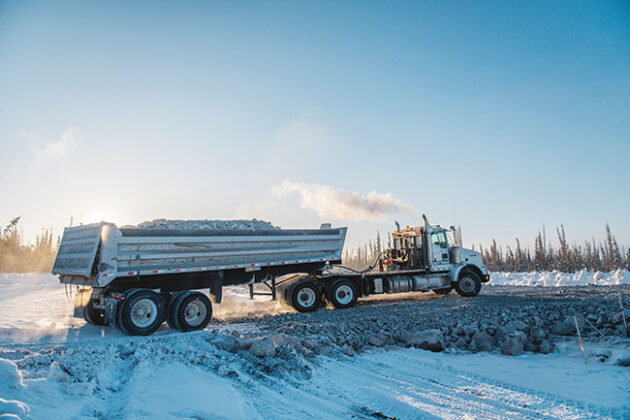
Features
Projects
Roads & Paving
Northwest Territories’ Mackenzie Valley Highway: slowly but surely
N.W.T. moving Mackenzie Valley Highway project forward
July 25, 2023 By Grant Cameron

The Northwest Territories (N.W.T.) is moving ahead, slowly but surely, on the long-anticipated next phase of the Mackenzie Valley Highway project.
The future leg of the thoroughfare will be a 321-kilometre-long stretch of two-lane, all-season gravel road that will run alongside the winding and tree-lined Mackenzie River from Wrigley, a designated authority in the Dehcho Region in the south, to Norman Wells, a town of nearly 700 in the Sahtu Region in the north.
The road will replace a seasonal winter road. In the south, it will link with a 1,150-kilometre-long section of highway that runs to Grimshaw, Alta. In the north, the Mackenzie Valley Highway will eventually be linked to public highways that connect to the Arctic Ocean.
Once completed, the highway will assert Canadian sovereignty in the North by providing an all-season transportation link connecting the isolated central Mackenzie Valley communities with the southern N.W.T..
A spokesperson for the N.W.T. Department of Infrastructure said in a statement compiled for Rock to Road that extensive environmental, socio-economic and technical work is being done in collaboration with Indigenous governments and community organizations to satisfy the requirements of terms of reference for an environmental assessment to ensure the project put forward is in the best interest of all area residents.
“All information collected is being compiled into a comprehensive Developer’s Assessment Report, which the Government of the Northwest Territories anticipates will be submitted to the Mackenzie Valley Environmental Impact Review Board in the coming months,” the spokesperson said. “Once submitted, the environmental assessment is expected to take 16 months to complete, followed by a five-month period for the responsible minister’s decision.”
Upon completion of the environmental assessment, the government expects an additional year will be needed to ensure all regulatory authorizations and permits are in place prior to advancing to construction.
“Construction cannot advance until the environmental assessment has been completed, regulatory authorizations and permits are acquired, and construction funding is secured,” the department spokesperson stated.
Completion of the highway has been talked about for decades. Hopes were raised in 2013, when the territorial government filed applications for land and water licences to build an estimated $1.67 billion roadway in accordance with the Mackenzie Valley Resource Management Act.
But 18 months later, the government shortened the highway by more than half to reduce the cost to roughly $700 million. Instead of linking to the Dempster Highway, the plan was to end it at Norman Wells, 321 kilometres from Wrigley. The Government of N.W.T. has since released a business case for extending the highway.
Terms of reference for the environmental assessment were established by the Mackenzie Valley Environmental Impact Review Board (MVEIRB) in 2015. Funding to advance the environmental assessment was secured in 2018 through an agreement under Transport Canada’s National Trade Corridors Fund. Canada and the Government of N.W.T. committed to cost share $140 million to advance the environmental assessment, and two community capacity building projects along the existing winter road alignment.
The department spokesperson said that, as the environmental assessment process continues, and engineering and design for construction advance, a revised construction cost estimate will likely be needed. “Large and systemic cost escalations are being experienced across the country and the Mackenzie Valley Highway construction cost is anticipated to have increased significantly.”

In 2013, the Government of N.W.T. filed applications for land and water licences to build a $1.67-billion roadway in accordance with the
Mackenzie Valley Resource Management Act. But the government later shortened the highway by more than half to reduce the costs.
A number of smaller projects along the route have already been approved or completed.
In late 2018, the government completed the Canyon Creek Access Road, a 14-kilometre-long, all-season access road from Norman Wells to Canyon Creek. It replaced a winter road that was constructed annually.
Last November, construction began on the first phase of the Prohibition Creek access road, a 6.7-kilometre thoroughfare from Canyon Creek to Christina Creek. Cost of the project is $25.5 million. Right-of-way clearing has been completed and drilling, blasting and embankment construction are in progress. The work is anticipated to be completed in the fall of this year.
A separate budget of $2.5 million has also been approved to cover the plan-ning and design work completed to date, as well as outstanding work required to make phase two of construction project shovel-ready. Phase two will see construction of 6.3 kilometres of all-season road from Christina Creek to Pro-hibition Creek.
The government is also currently working to complete land acquisition, attain permits and complete the design for the Great Bear River Bridge adjacent to Tulita. Regulatory applications are expected to be submitted this year.
However, there is a wrinkle in a project near Wrigley where a proposal has been put forward to realign a 15-kilometre portion of the highway from Hodg-son Creek to Mount Gaudet.
Regulatory permit applications were submitted to the Mackenzie Valley Land and Water Board in the fall of 2020. However, the Pehdzéh K ı̨́ First Nation (PKFN) has expressed concerns with various aspects of the project.
The regulatory process for the project is currently on pause until additional engagement and technical work is completed to the satisfaction of the PKFN. The government has recently re-engaged with PKFN and is developing an action plan to move the project forward.
When fully completed, the Mackenzie Valley Highway will connect Canadian public highways to the Arctic Ocean. Gravel has been chosen as maintenance costs associated with upheaval and permafrost are more expensive for paved roads.
In addition to asserting Canadian sovereignty, the road will mitigate the effects of climate change on current winter road infrastructure and decrease the cost of living for area residents by increasing access to goods and services.
Meanwhile, the road will enable the N.W.T. to incentivize economic diversifica-tion and development in the region. Construction of the road will create thou-sands of new jobs and valuable business and training opportunities.
Completion of the environmental assessment and regulatory and permitting processes is anticipated to take two to three years, according to the department spokesperson. Construction of the highway itself will take several years to complete. Construction may advance in phases, sequentially or in sections, concurrently.

In addition to asserting Canadian sovereignty, the road will mitigate the effects of climate change on current winter road infrastructure and decrease the cost of living for area residents by increasing access to goods and services. Photos: Government of N.W.T.
The project is expected to be challenging due to its remote location. Engineers must figure out how to minimize the impact of the project on the environment and deal with material and labour shortages.
“Advancing a project of this scale is not a simple process and requires careful planning,” said the department spokesperson.
As design for the project advances, it will require land access agreements with Indigenous land holders, not only for the highway itself, but also to ensure access to appropriate aggregate and other materials. Construction, operation, and maintenance activities will need to factor in waste, water and wildlife management.
“Logistics associated with ensuring equipment and supplies are available and can be mobilized is always a concern, especially given recent inflationary pressures related to the COVID-19 pandemic, which are impacting the construction sector not just in the Northwest Territories, but across Canada,” the department spokesperson said. “Increased material costs, fuel costs, labour shortages, and supply chain issues are all resulting in projects costing much more than originally estimated.”
The Government of N.W.T. is replacing seasonal winter ice roads with all-season roads in order to make the transportation system more resilient to climate change impacts.
“The Department of Infrastructure recognizes the challenge climate change presents and is the taking necessary steps to ensure public infrastructure is more resilient to the impacts of a warming planet and can meet the current and future needs of N.W.T. residents,” N.W.T. Infrastructure Minister Diane Archie said in a recent speech.
Print this page